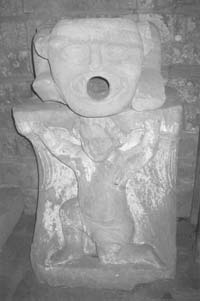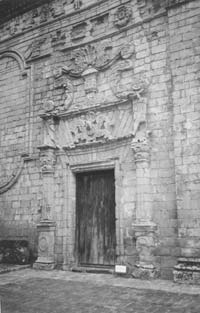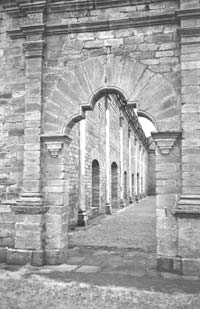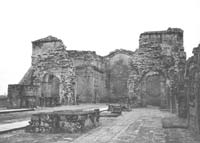Guaraní-Jesuit missions of Paraguay
by Julie Skurdenis
Last month I described three Guaraní-Jesuit missions my husband, Paul, and I visited in Argentina in August ’07. This month I’d like to describe two more, these in Paraguay, that we visited on a separate trip several weeks after seeing the Argentinian missions.
Jesus Mission
The first of the two Paraguayan missions we visited, Jesus de Tavarangüe, was founded in 1685. Located 25 miles north of Encarnación, Jesus Mission followed the usual Jesuit mission layout with a church at the southern end of a plaza with adjoining patios, one with classrooms and one with workshops.
The church, as with the Argentinian mission churches we visited, is huge with high stone walls still in place and remnants of interior columns that divided the nave into three aisles.
What is especially noticeable about the Jesus Church are the beautifully carved doorways in a variety of architectural styles: Romanesque, Renaissance and even an arabesque doorway that was probably meant to imitate a Moorish doorway in Spain.
Carvings still vividly visible on the church walls are in a style that has been called “ Guaraní Baroque,” a simpler, scaled-down version of European Baroque carving that has an appealing naive charm. Stone angels float above niches while abundant fruits and flowers frame other wall openings. Everywhere, Guaraní influence is evident. An estimated 3,500 Guaraní once lived in Jesus Mission.
Trinidad Mission
La Santisima Trinidad del Parana is located just seven miles from the Jesus Mission. Built in 1706, Trinidad is unique in that it has two churches and two cemeteries. Apparently, a grander church replaced the earlier structure and a second cemetery was built adjacent to the newer church.
Despite this difference, there is still the Guaraní-Jesuit mission “pattern” of a large central plaza with stone houses on three sides. A colegio, or school, and workshops surround patios to one side of the newer church. A paved stone terrace lined with columns still stands outside the patio where the colegio was located.
The glory of Trinidad, however, is its second church, an impressive structure with walls still intact. As with other Guaraní-Jesuit churches, it must have been magnificent.
The stone paving remains, as do beautifully carved doorways framed by columns and topped with Baroque curlicues. There are also statues, a resplendently carved Baroque pulpit, a large baptismal font with “Ano 1720” carved on it, and numerous carved fragments that are displayed in a small museum next to the church.
Also outstanding are the Romanesque arcades that once stood in front of the Guaraní houses and a bell tower attached to the earlier church that looks like a turret from a medieval castle.
If you go. . .
We cannot recommend the company that arranged our day trip to Jesus and Trinidad missions, C&C Tours in Buenos Aires, or its colleague in Asunción, DTP Tours. Neither warned us that our “tour” meant taking the public bus to Encarnación and making many stops along the way or that the 250-mile-long trip would take almost seven hours each way.
By the time we finally arrived in Encarnación, it was two hours to closing time at the missions. We barely had time for a brisk walk through the two missions before having to rush to catch the bus back to Asunción, arriving past midnight.
It is far better to either hire a car and driver to make the drive from Asunción to the missions in less time and, consequently, have more time to explore the two missions or to overnight in Encarnación, avoiding two long drives in one day.
In Asunción, we stayed at the comfortable Excelsior Hotel (Chile 980, Asuncion, Paraguay; phone 595 21 495 632, fax 595 21 496 748, e-mail excelsior@excelsior.com.py or visit www.excelsior.com.py) in the city’s historic downtown area. Room rates start at $99 for a standard double.
If you see nothing else in Asunción, don’t miss the superb Museo del Barro at Grabadores del Cabichui s/n, one of the best folk art museums we have ever visited. It’s a 20- to 30-minute taxi ride from downtown Asunción and is open from 3:30 to 8, Wednesday to Sunday.
We spent four nights in Asunción as an excursion from Buenos Aires, a 2-hour flight away.




